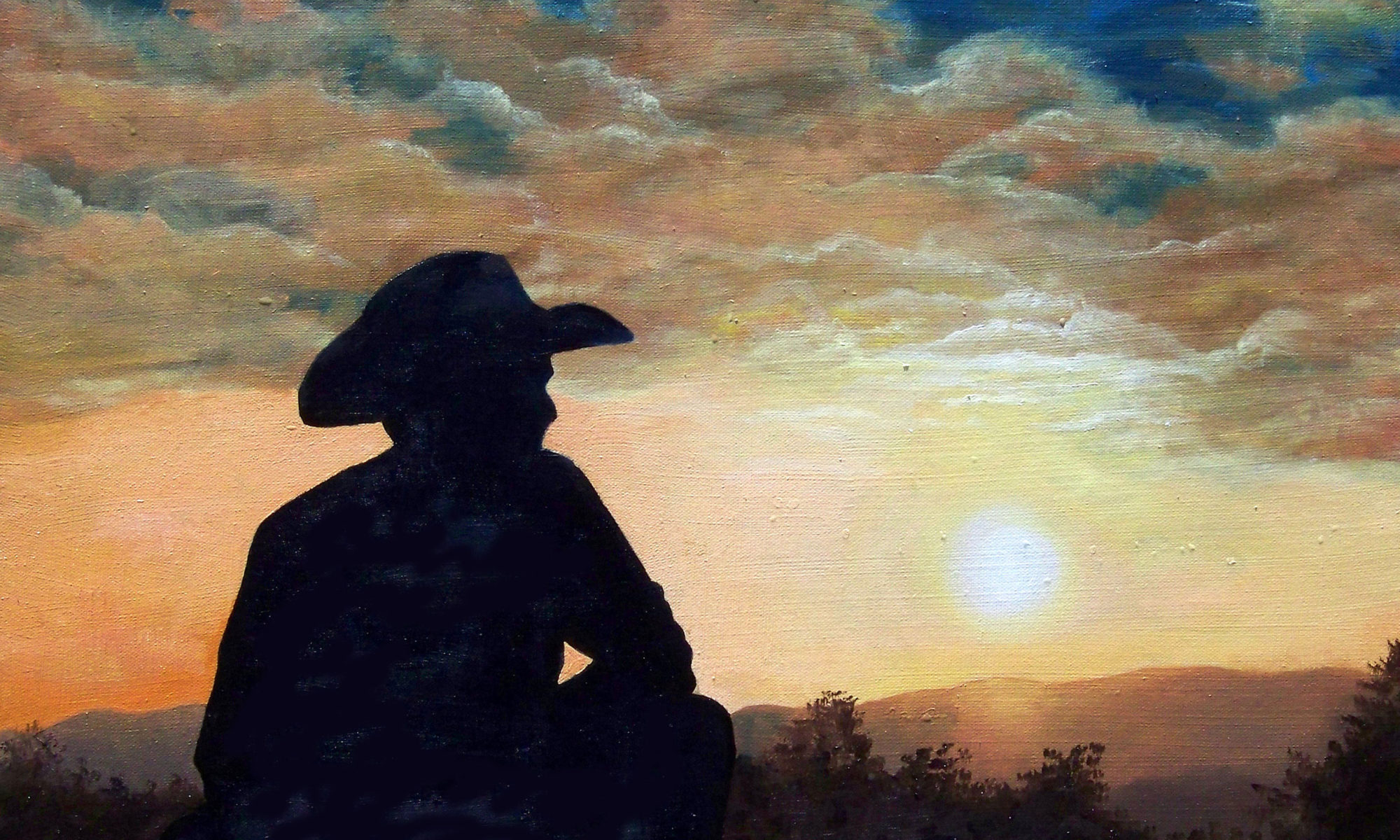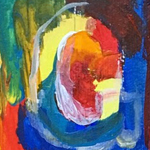
GALLERY | GUERRILLA KNITTING
Quick links to more art terms and definitions are located at the end of the list.
Gallery
Refers to a building, hall, room, or series of rooms where sculpture, paintings, photographs, or other works of art are exhibited and or sold. Unlike museums, galleries focus on displaying contemporary and current artworks, often showcasing innovative pieces by rising artists. Visitors can view the art, engage with it, and inquire about purchasing specific works.
Gallery-Wrapped Canvas
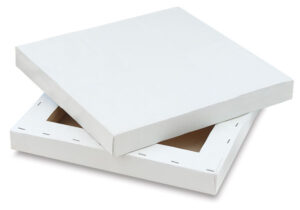
A type of canvas used by artists to create paintings on top of the canvas surface. Canvas fabric is stretched across and wrapped around wooden stretcher bars. It is then attached to the back of the stretcher bars using staples or spline. Gallery-wrapped canvas allows artists to paint on the sides or edges of the canvas and to hang it without a frame. Some artists and collectors prefer the more contemporary look of unframed art.
For more information see blog article “Three Types of Oil Painting Canvas.”
Genre
(A French word meaning “kind” or “genus.”)
A realistic style of painting that depicts scenes of everyday life. Dutch artworks of peasant and tavern scenes are considered typical genre paintings.
Genre Painting
A realistic style of painting that depicts scenes of everyday life. It shows average folks going about their lives, whether they are at work or having fun. These paintings feature intimate scenes of daily life, costumes, residential settings, interiors, festivities, bar scenes, marketplaces, and other street scenarios. It might also represent a crowded street, a beach party, a dinner gathering, or any other location where life happens. Dutch artworks of peasant and tavern scenes are considered typical genre paintings.
Geometric Art
An art movement that emerged in the early 20th century by artists fascinated with geometric shapes. Inspired by geometry, a type of mathematics, geometric art is a form of abstract art that uses basic shapes like squares, circles, triangles, and rectangles in its designs. Geometric artworks can be created using various materials like paint, ink, pencil, paper, metal, and plastic. And it is often used to create seamless patterns, abstract backgrounds, and various photo effects.
Geometric Symmetry
Refers to a specific type of symmetry that arises from precise mathematical relationships and regular shapes. In geometrically symmetrical compositions, elements are arranged in a way that maintains balance through mirroring, rotation, or repetition. Unlike more organic or freeform symmetries, geometric symmetry relies on strict rules and predictable patterns.
Geometric symmetry plays a crucial role in art, providing a foundation for balance, harmony, and visual order. It ensures that elements within an artwork are evenly distributed. Regular shapes—such as squares, triangles, or circles—often serve as building blocks. By duplicating elements precisely, artists achieve a sense of equilibrium. Think of tessellations—those repeating patterns without gaps or overlaps. They captivate viewers with meticulous arrangement and optical illusions.
Gesso
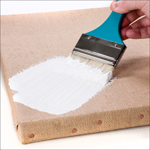
A primer or coating made of plaster, chalk, or gypsum, bound with glue, applied to canvases to ensure they are suitable for paint application. Without this layer of primer, the paint would soak into the weave and possibly damage the canvas material. When applying multiple layers of gesso, it is best to lightly sand each layer before applying the next one. Gesso can be applied to just about any surface and may be painted on with acrylic or oil paint. It can also be built up, molded into relief designs, or carved.
Gesture Drawing
A freehand drawing technique used by artists to quickly capture the action, form, and pose of a model or figure. It involves using the whole arm with loose movements, focusing on the shape rather than details. This method is beneficial in improving the hand and eye coordination for artists of all levels, from beginners to experienced.
Giclee
(Pronounced “zee-clay”) a printmaking process usually on an IRIS inkjet printer to make reproductions of a photograph or painting. The printer can produce a vast range of colors, resulting in prints that are of exceptionally high quality.
GIF
An acronym for “Graphic Interchange Format,” an image format type generated specifically for computer use. Its resolution is usually very low (72 dpi, or that of your computer screen), making it undesirable for printing purposes.
Gilding
A decorative method that involves applying a thin layer of gold or similar metal to solid surfaces such as metal, wood, porcelain, or stone. The process enhances the object’s appearance, creating a luxurious and ornate finish.
Glaze
Refers to a thin, translucent layer of acrylic or oil paint applied to a painting. It modifies the appearance of the underlying paint layer, altering aspects such as chroma, value, hue, and texture. Glazes consist of a small amount of pigment mixed with a greater amount of binding medium. Artists use glazing to create depth, enhance luminosity, and allow underlying colors to shine through.
Gold Leaf
An extremely thin tissue of actual gold used primarily for gilding—decorating surfaces with a layer of gold. It has been employed in various artistic contexts throughout history. Gold leaf can be applied to various surfaces, such as:
-
- Paper: Gold leaf adheres beautifully to paper, creating a radiant effect. Think of religious icons, where halos and backgrounds often feature gold leaf.
- Wood: Furniture, frames, and wooden sculptures can be gilded with gold leaf.
- Ceramics: Porcelain and pottery gain a lustrous finish when adorned with gold leaf.
- Glass: Stained glass windows sometimes incorporate gold leaf for added brilliance.
- Textiles: Although less common, gold leaf can be applied to fabric or textiles.
- Metal: Even metal surfaces, such as jewelry or decorative metalwork, can benefit from gold leaf.
Golden Age of Illustration
An era, spanning roughly from the 1880s to the 1930s, which was marked by unprecedented excellence in book and magazine illustration. Although it isn’t officially recognized as a distinct historical era within the art world, its impact remains significant.
The Golden Age of Illustration emerged due to technological advancements that allowed accurate and inexpensive reproduction of art. Specifically, the halftone printing process became mainstream during this time. And by the early 1900s, full-color reproduction had also become advanced enough for use in magazines and books. This enabled artists’ work to be directly reproduced in all its glory.
The Golden Age of Illustration was a time when technology, industrialization, and a voracious appetite for new graphic art converged. It brought forth a wealth of beautifully crafted illustrations that continue to captivate us today.
Golden Ratio
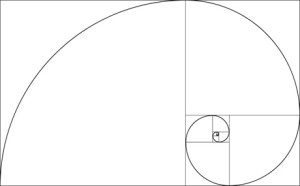
(Also referred as the golden mean.)
A compositional technique that creates harmonious proportions in paintings by utilizing a mathematical ratio found in nature. It is an actual ratio of 1:1.618, which can be demonstrated by drawing a rectangle with a width of 1 and a length of 1.618. Within this rectangle, there is a square with a ratio of 1:1 and another rectangle with a ratio of 1:1.618. If another square is drawn within the smaller rectangle, it will have a ratio of 1:1 and another rectangle with a ratio of 1:1.618. This ratio can create beauty and balance in the layout and design of all paintings. The point where the diagonal lines intersect is crucial when using this ratio to compose your paintings, as it is infinitely divisible, allowing multiple intersections for sub-elements.
Goniochromism
(Also known as iridescence.)
A fascinating phenomenon where certain surfaces—whether in nature or man-made—appear to change color as if they’re putting on a shimmering cloak when you shift your viewing angle or the angle of illumination. This captivating effect happens due to wave interference of light in microstructures or thin films. Whether it’s the glimmering green of beetle wings or the rainbow hues in seashells, iridescence adds a touch of magic to our world.
Good Design Principles
(Also referred to as the principles of design or the principles of composition.)
Refers to a set of guidelines or principles that are the backbone of effective and visually engaging design. Good design isn’t just about aesthetics; it’s about solving problems, enhancing experiences, and making life better. These principles aren’t rigid rules; they’re simple tools for effective communication.
The design principles are:
-
- Balance ensures visual stability. It can be symmetrical (equal weight on both sides) or asymmetrical (unequal but visually balanced).
- Contrast involves juxtaposing different elements (e.g., light vs. dark, big vs. small) to create visual interest.
- Emphasis directs the viewer’s attention to a specific element within a design. It’s about making something stand out.
- Hierarchy organizes information by importance. It guides the viewer’s eye.
- Repetition creates consistency and reinforces visual themes. It unifies a design.
- Rhythm establishes a visual flow. It’s like a beat or pattern within a design. Repeat visual elements at regular intervals to create rhythm.
- Pattern involves repeating motifs or shapes. It adds interest and predictability. Use patterns in backgrounds, textures, or decorative elements.
- Proportion deals with the size relationship between elements. It ensures harmony.
- Unity ensures that all elements work together as a cohesive whole.
- White space (negative space) is the empty area around design elements. It provides breathing room.
Gothic Art
A medieval style of art that emerged in Northern France in the 12th century. It is distinguished by meticulous workmanship, elaborate decorations, and religious themes. It evolved from Romanesque art and Gothic architecture and is commonly linked with towering cathedrals with pointed arches, ribbed vaults, and spectacular stained glass. Renaissance Italian writers developed the term Gothic to describe the evolution of medieval architecture after the barbarian Gothic tribes destroyed the Roman Empire and its classical culture in the fifth century.
Gouache
A type of watercolor paint made heavier and more opaque by the addition of a white pigment (chalk, Chinese white, etc.) in a gum arabic mixture. This results in a stronger color than ordinary watercolor.
Gradation
The gradual transition between opposites—whether it’s from one color to another, from lighter to darker shades, large shapes to smaller ones, or other visual elements. Gradation is a powerful technique that artists use to create harmony and unify their compositions. It ties together things that might otherwise compete with each other.
Graffiti Art
(Also called Street Art.)
A term used to describe visual artwork that has been spray-painted, drawn, or inscribed on public surfaces such as walls and sidewalks. While some view it as vandalism, others appreciate it as a form of expression aimed at beautifying urban landscapes by transforming dull or empty spaces.
Graphic Art
A diverse visual expression, often created on flat surfaces. It uses a variety of techniques to represent subjects, including drawing, painting, and photography. It also includes decorative elements, patterns, and designs for aesthetic purposes. Graphic art can be textual or use printing techniques like engraving. Most graphic art is two-dimensional, with emphasis on line, color, and tone. It combines creativity, technique, and visual communication to create captivating and expressive works.
Graphic Artist
Graphic artists are creative professionals who create visual materials to convey emotions, stories, and messages to audiences. They focus on artistic expression and work in both traditional and digital media. They create original artwork, illustrations, or animations for various projects, including advertisements, posters, book covers, comic books, graphic novels, animations, film illustrations, and cartoons. Graphic artists use their skills and tools to design images, logos, illustrations, animations, and other elements for various media and purposes.
Graphic Design
The art of arranging images and text to convey a message, applied in various media like print, digital, motion pictures, animation, product decoration, packaging, and signs. As a practice, graphic design traces its beginnings back to the origin of the written word. However, it only became identified as a separate entity in the late 19th century.
Graphic Designer
(Often used interchangeably with the term “graphic artist.”)
A specialist who creates and communicates visual concepts through the integration of technology and art. Graphic designers focus on effective communication strategies within specified specifications utilizing text, images, colors, fonts, and other elements to design and layout information for a variety of mediums such as websites, printed pages, brochures, magazines, banners, and advertisements. Their goal is to inform, inspire, and captivate consumers with their designs, reflecting the desired message and brand of their clients or customers. They ensure readability and aesthetically pleasing layouts using principles like contrast, balance, and visual hierarchy.
Graphite
A metallic gray writing and drawing material made of carbon primarily used in pencil form. Artists use graphite for drawing. Graphite’s thin, refined strokes create delicate lines, making it a versatile tool for both preliminary sketches and final pieces.
Grayscale
(Also known as monochrome.)
Refers to an image composed exclusively of shades of gray. It’s the range of gray tones between black and white (see the illustration below). Unlike full-color images, which use a spectrum of colors, grayscale images rely solely on variations of black, white, and the intermediate grays in between. Each shade of gray represents a specific amount of light transmission. At the lowest intensity, black signifies the total absence of light, while at the highest intensity, white represents total light transmission or reflection.
Grayscale is one of the core fundamentals of art, akin to perspective, color theory, composition, and anatomy. Understanding values (the lightness or darkness of tones) is crucial for any artist, regardless of their chosen style.
![]()
Green

The color that is created when blue and yellow (primary colors) are mixed together. Green is one of the three secondary colors (orange, green, and violet) on the color wheel. (See Secondary Colors.) The complement or opposite of the color red. Part of the RGB color model used on television and computer screens.
Grid
Refers to a series of crossed lines that meet to form a boxed pattern used in the predetermined placement of photographs and graphic elements on a canvas. Helpful in creating compositions.
Grid Enlarging
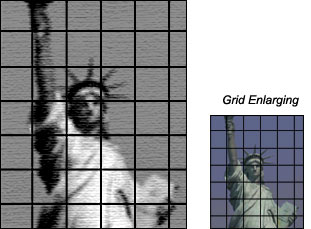
The process of using a grid to enlarge an image; for hand drawing very precisely another image on the same or a different scale, usually larger; used in scaling an image by drawing. For more information on using this method, see the article titled Using a Grid to Enlarge and Transfer an Image to Canvas.
Grisaille
Monochrome painting generally employs shades of gray executed in a black pigment and an inert white pigment in oil, gouache, or tempera; a stained-glass window incorporating muted tones as opposed to bright colors.
Group of Seven
Canada’s first internationally recognized art movement. It played a pivotal role in shaping Canadian art during the early 20th century. Founded in 1920, The Group of Seven consisted of self-proclaimed modern artists who shared a common vision. The group primarily focused on landscape painting, especially scenes from northern Ontario. Their paintings captured the rugged beauty of Canada’s wilderness, emphasizing its unspoiled terrain.
Guerrilla Art

(Also called Street Art.)
A form of art-making that entails installing unauthorized works of art in public places. This form of art expression allows the artist to express their views and opinions to a large audience anonymously. Such statements can be either political or merely to call attention to one’s surroundings. Guerrilla art differs from other forms of art. It is inherently environmental and does not rely on conventional mediums like canvas. Traditional artworks can be transported between galleries without altering their essence or interpretation; however, guerrilla art is different. The very surface that it adorns often plays a crucial role in the significance of the work, just as much as the artwork itself.
Guerrilla Knitting
(Also known as yarn bombing or yarn graffiti.)
A form of street art that involves covering objects or structures in public spaces with colorful knitted or crocheted yarn. This crafty approach uses soft and snug materials instead of the usual graffiti mediums like paint or chalk, offering a unique transformation of the urban environment.
You May Also Like
This glossary of art definitions is provided as a valuable resource for art enthusiasts. If you like the information here and find it helpful, please consider purchasing a painting. Your support helps to cover the cost of keeping this art vocabulary and meanings lexicon online. Simply click or tap the thumbnail link of any Teresa Bernard oil painting to view additional details.
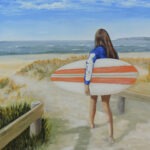
(2022)
12″ w x 16″ h
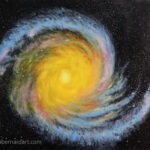
24″ w x 18″ h
Art Glossary Quick Links
Contributing to The Art Dictionary
The art definitions glossary is a constantly evolving resource, with new terms and definitions added regularly. If you discover an unlisted art term or definition, please submit it and we will consider adding it. We’ll let you know if we do. Thanks!
Thanks for reading this!
